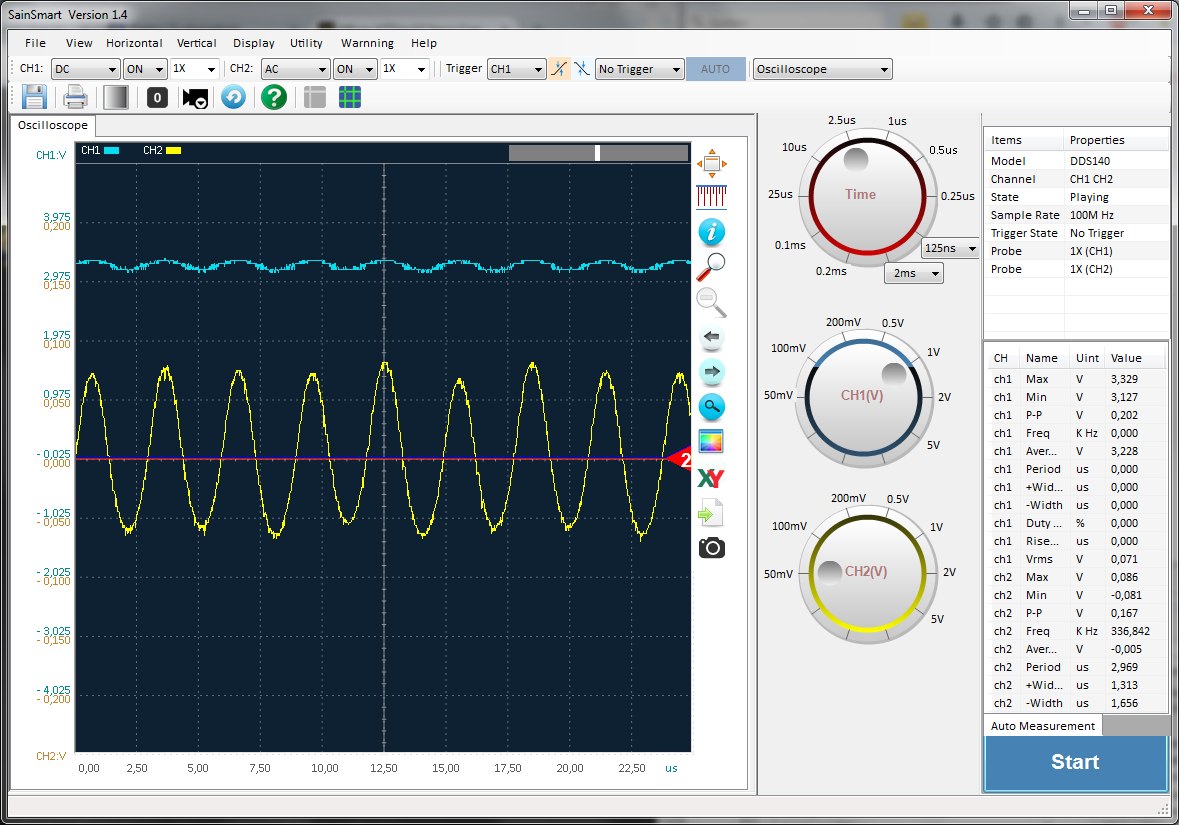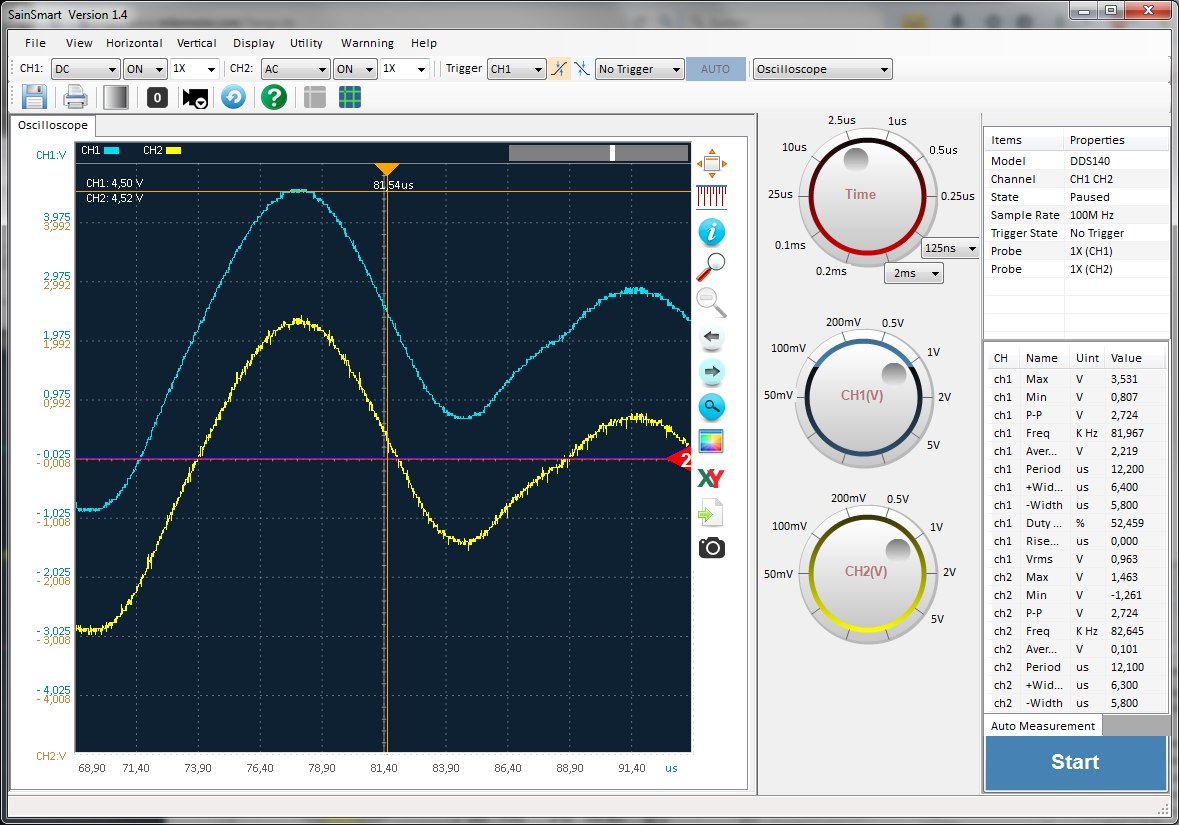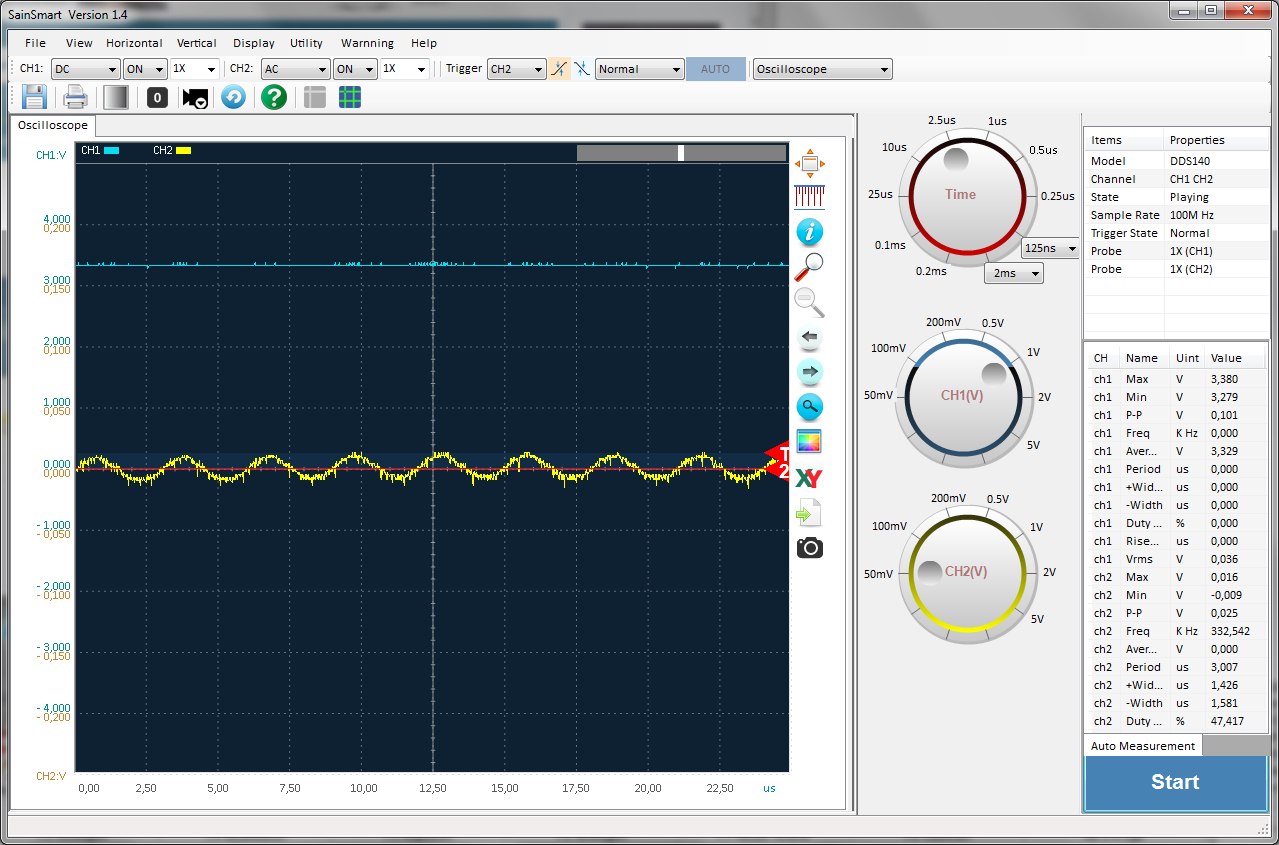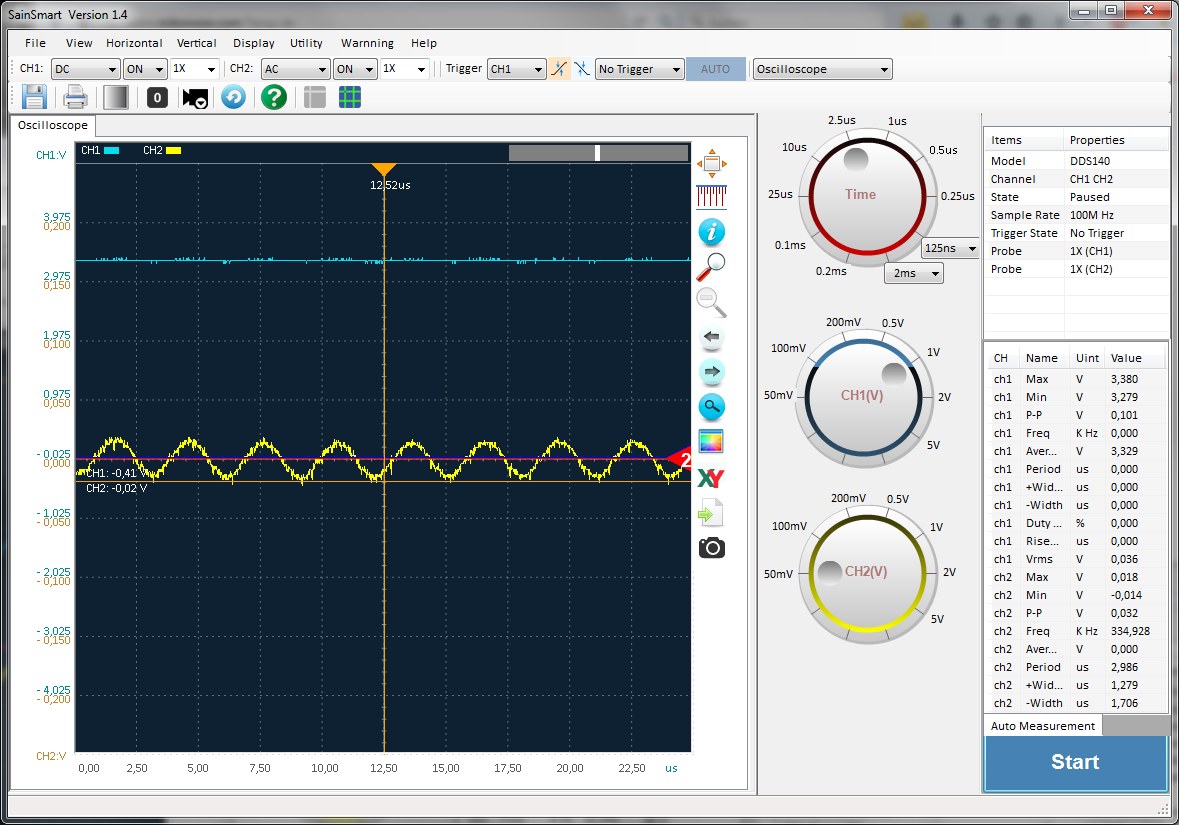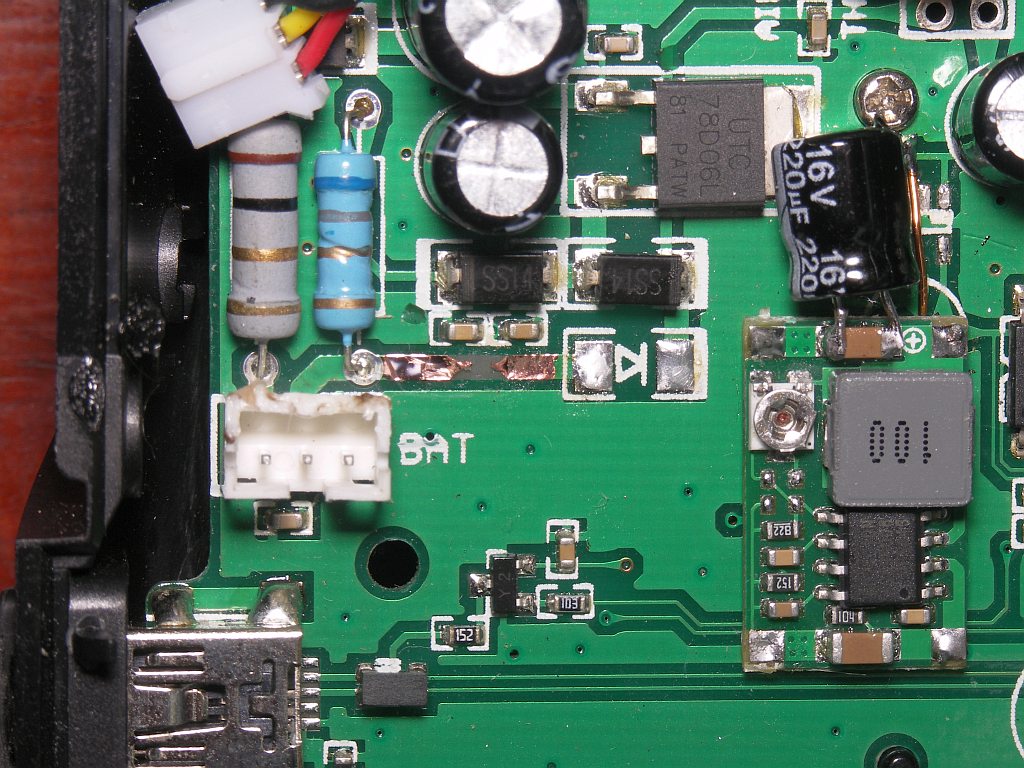- Posts: 49
Devo 7e - Voltage supply
- bianchifan
-
Topic Author
- Offline
Not enough, I spent a 2S ZOP Power LIPO so the heated voltage would increase till eternity..
I read several statements about fried LDOs with added modules, datasheet told me 100mA max.
Therefor that small bug was stripped too.
First I wanted to implement a KIS-3R33S module, it's well known for good quality but it's designed for ~3A and the graph in datasheet starts at 150mA..?
At least I did a short compare against an 1A-mini-BUCK, I checked open ouput, 30mA, 50mA and 100mA.
In all cases the mini-Buck produces less ripples, the KIS modules suckes at open output condition so my choose was the mini-Buck.
Some pics, all @openOutput
KIS-3R33S @5V2
KIS-3R33S @8V4
Mini-Buck @5V2
Mini-Buck @8V4
Accidently I built a short ..
Normally the Schottky should have been fried... but in my case the PCB trace melted away and the diode survied with a slightly damaged housing.
1A-Diode (40A ! peak) for an 100mA LDO ?? Yeah, perfectly desinged
Please Log in or Create an account to join the conversation.
- Fernandez
-
- Offline
- Posts: 983
I run my devo 7e also wit a switch up/dwon regulator, it works fine, but still......
I have my devo battery voltage readout fluctuating on some protocols such as Frsky.....
Putting a large cap on the voltage sense line does not help....
Putting large cap over the 3v3 seem not to help either...
I was thinking to get rid of the whole power circuitry of the devo, install two 18650 3400mah in parallel (it fits minor mods needed, I tested that) and charge them over usb, with small lion charger module.
The Pololu have an enable pin, I was thinking to charge a capacitor on that pin, to be able to keep Tx powered few seconds after switch off for save to prom.
Anyway I never find time to do it and now will be on holidays, coming weeks.....
Please Log in or Create an account to join the conversation.
- robpur
-
- Offline
- Posts: 47
www.deviationtx.com/forum/7-development/...dule?start=780#52623
Please Log in or Create an account to join the conversation.
- Fernandez
-
- Offline
- Posts: 983
Please Log in or Create an account to join the conversation.
- robpur
-
- Offline
- Posts: 47
Please Log in or Create an account to join the conversation.
- bianchifan
-
Topic Author
- Offline
- Posts: 49
May you plz tell a little more?Fernandez wrote: ..but still......I have my devo battery voltage readout fluctuating on some protocols such as Frsky......
That was also my first idea but I didn't found a satisfying solution, the battery cave is too small.Fernandez wrote: I was thinking to get rid of the whole power circuitry of the devo, install two 18650 3400mah in parallel (it fits minor mods needed, I tested that) and charge them over usb, with small lion charger module.
If I wouldn't have found that appropriate Lipo I may have choosed 4pcs (1S4P) 14500 LiIons.
What prom? The flash? Try an RC element directly on the supply pins.Fernandez wrote: ..The Pololu have an enable pin, I was thinking to charge a capacitor on that pin, to be able to keep Tx powered few seconds after switch off for save to prom...
I started this thread because I was wondering about the different module behaviour, both are driven by MP2307.
Sadly I cannot test more for my Devo refuses any work at time , I'm very interested in the ripple in concrete situations.
If there aere weired things like oscillating voltage readings and similar shit I would rise the voltage up to 3.6V to feed an exquisite LDO, LP2992 for instance.
edit:
LP2992 is fine but when writing I thought on a MCP1702..
Please Log in or Create an account to join the conversation.
- Fernandez
-
- Offline
- Posts: 983
bianchifan wrote:
May you plz tell a little more?Fernandez wrote: ..but still......I have my devo battery voltage readout fluctuating on some protocols such as Frsky......
Just check the display of 7e battery Voltage, when using frsky at full power do you get stable 5.0Volt etc, I get up to 0.2.03V fluctuations, looks a bit randomly moving around.
That was also my first idea but I didn't found a satisfying solution, the battery cave is too small.Fernandez wrote: I was thinking to get rid of the whole power circuitry of the devo, install two 18650 3400mah in parallel (it fits minor mods needed, I tested that) and charge them over usb, with small lion charger module.
If I wouldn't have found that appropriate Lipo I may have choosed 4pcs (1S4P) 14500 LiIons.
Yes tw 18650 such as the NCR3400, they certainly fit into devo 7e. You cannot use the 4AA tray, and need to cut/remove very little of the mid section of the plastic material inside devo 7e. this is not destructive, still you can go back to the 4x aa battery holder. The 18650, to be fitted permanently, cant get out without opening the TX.
What prom? The flash? Try an RC element directly on the supply pins.Fernandez wrote: ..The Pololu have an enable pin, I was thinking to charge a capacitor on that pin, to be able to keep Tx powered few seconds after switch off for save to prom...
I use step up step down pololu S7V8F3 so even with a lower Vin it wil step up to 3V3, it works reliably over wide range, Iuse it now in my devo..
www.pololu.com/product/2122
I started this thread because I was wondering about the different module behaviour, both are driven by MP2307.
Sadly I cannot test more for my Devo refuses any work at time , I'm very interested in the ripple in concrete situations.
If there aere weired things like oscillating voltage readings and similar shit I would rise the voltage up to 3.6V to feed an exquisite LDO, LP2992 for instance.
Please Log in or Create an account to join the conversation.
- robpur
-
- Offline
- Posts: 47
Fernandez wrote: check this post also ; www.deviationtx.com/forum/6-general-disc...rvolted-devo7e#43231
I have my devo battery voltage readout fluctuating on some protocols such as Frsky.....
Are you talking about the built-in battery voltage monitor fluctuating? When you asked me about voltage fluctuations while running the FrSky protocol I assumed you were talking about using external equipment such as a scope to monitor the battery and/or 3.3V supply. If built-in battery voltage motoring is what you want me to check then that's easy to do, but I don't know how meaningful it would be. The internal voltage monitoring system is not very robust and could easily be effected by noise. Especially if the input to an external regulator is attached to the FET ahead of the built-in regulator. I think this is where the built-in battery voltage monitoring system gets its input, so if noise from an external switching regulator gets in then the voltage monitor could become erratic.
Please Log in or Create an account to join the conversation.
- robpur
-
- Offline
- Posts: 47
Fernandez wrote: The Pololu have an enable pin, I was thinking to charge a capacitor on that pin, to be able to keep Tx powered few seconds after switch off for save to prom.
No need to add a cap. Just wire it differently. Wire the inputs of the Pololu directly to the battery and connect the shutdown pin (with pull up resistor removed) to the FET.
Please Log in or Create an account to join the conversation.
- Fernandez
-
- Offline
- Posts: 983
so I was wondering how stable is your readout, at frsky full power?
Yes I could mount the polulo to the fet, but why not remove all those diodes charger and switch circuit, just pololu up/down to the lion battery and switch o/off with the enable pin of Polulo, then only thing when power off it needs to be powered for few seconds, so I thought adding capacitor.
But anyway I still do not understand why my power fluctuates, even with the polulo, similar fluctuation as when stog Vreg.
Please Log in or Create an account to join the conversation.
- robpur
-
- Offline
- Posts: 47
Have you tried measuring the voltage with a meter other than what’s built into the Devo? If so, did you still see the fluctuations? Have you put a scope on it to check for noise? The cap that you put on the processor pin may not be appropriate for the frequency of noise that’s being generated. A different value of cap or an RC or LC network might be required to suppress the noise. That is, if it’s a noise issue.
As for removing all the diodes and such, it depends on your philosophy. You ask “why not remove them” while I say “why remove them”. I prefer to take a minimally invasive approach, but to each their own. There’s no wrong way as long as things work as desired.
Please Log in or Create an account to join the conversation.
- bianchifan
-
Topic Author
- Offline
- Posts: 49
Not possible with missing "Walkera module"..Fernandez wrote: Just check the display of 7e battery Voltage, when using frsky at full power do you get stable 5.0Volt etc, I get up to 0.2.03V fluctuations
5V????
My actual voltage is 3.252 V.
I just noticed your pic in your pointed thread, your module is feeded by the MosFet.Fernandez wrote: The Pololu have an enable pin, I was thinking to charge a capacitor on that pin, to be able to keep Tx powered few seconds after switch off for save to prom.
When the FET cuts the line the power dies down, how should the enable pin can help?
You must buffer the power input of the "prom circuitry".
BUt without schematics/analysing the PCB routes I cannot help at the moment.
so the FETs shuts down the power and the Pololu eats quiescent power and eats and eats....but no buffer for the promrobpur wrote:
..Wire the inputs of the Pololu directly to the battery and connect the shutdown pin (with pull up resistor removed) to the FET.Fernandez wrote: ...enable pin...
Please Log in or Create an account to join the conversation.
- robpur
-
- Offline
- Posts: 47
bianchifan wrote: so the FETs shuts down the power and the Pololu eats quiescent power and eats and eats....but no buffer for the prom
Quoted from the Pololu website.
" While the SHDN pin is being driven low, the current draw of the regulator is dominated by the current through the pull-up resistor and will be proportional to the input voltage. (At 36 V in it will draw about 360 μA.)"
So the maximum current draw when the regular is in shut down mode is 360 μA, and that current decreases as input voltage decreases. Since the majority of that current is drawn through the pull up resistor that has been removed, and the input voltage is under 6V, then the quiescent current is quite low and should not be a concern. Based on the loose language used in the Pololu statement the quiescent current with a 6V input would be 60 μA. That figure is dominated by the pull up resistor so with that resistor removed then current draw should be less than 50% of 60 μA. So we are talking about less than 30 μA at a maximum, and probably somewhere under 20 μA.
Let's see. 20 μA is 0.00002 amps and I'm using 2Ah NiMh batteries. Dividing the amp hour rating by the current draw (2/0.00002=100,000). So it would take 100,000 hours to completely deplete the batteries, or 4,166 days. That's if I got my math right.
Since the shut down pin of the Pololu is being driven by the same source that supplies power to the onboard linear regulator, then the so called "buffering" system that allows writes during TX shutdown should work as normal since the Pololu would be shut down with the same timing as the stock regulator.
Please Log in or Create an account to join the conversation.
- bianchifan
-
Topic Author
- Offline
- Posts: 49
More than once I made the experience that the stated data are one thing.robpur wrote: .. the maximum current draw when the regular is in shut down ...
And the other thing are mystic circumstances when the quiecent current explodes suddenly from uA to A..
We do not play with military proved devices, only with cheap dirty circuits.
Weired things may happen...
Shutdown.. I refered only to Fernandez' idea "seconds", nothing else
Fernandez wrote: ... to keep Tx powered few seconds after switch off....
I'm not familiar with this stuff, neither devo's routing/schematics nor deviation firmware, I do not know why and what.
Please Log in or Create an account to join the conversation.
- Elmtree
-
- Offline
- Posts: 60
robpur wrote: I installed a switching regulator in my 7E last night and posted details in another thread before noticing this one. Post can be found here.
www.deviationtx.com/forum/7-development/...dule?start=780#52623
Hey Robpur, I was thinking about doing this mod because I want to use LiPo or lion batteries so that I can use my LRS with the same power system. Anyways, is 500mA enough with the new modules, or have you found it getting hot?
Thanks
Please Log in or Create an account to join the conversation.
- robpur
-
- Offline
- Posts: 47
Keep in mind that the Pololu I installed only supplies 3.3V power to the additional modules. It does not replace the stock 3.3V regulator. Therefore the stock regulator would run hotter than normal if I was using a higher voltage battery pack. Some users get away with it, even when powering additional RF modules with the stock regulator, but it goes beyond the design specification of the TX. The Pololu could also replace the stock regulator with a simple wiring change, but that increases the potential of unwanted side effects.
As I mentioned earlier in this thread I prefer a minimally invasive approach. I figure that the TX was designed by professional engineers and they knew what they were doing. I’m sure compromises were made based on economic and marketing decisions, but the TX as supplied from the factory is stable and dependable. Problems start when we as hobbyist want the TX to do more than the engineers intended, and we make additions and modifications that can compromise the original design. Some of these modifications are required if we want multi-protocol, while others are optional, and sometimes based only on preference.
When modifying my own radio I look at the cost vs the benefit. I’m not just talking about money, but also the cost of causing problems that I might have to spend time fixing, and perhaps causing instability. This is why I’ve chosen to continue using NIMh batteries, the reason for using the shutdown feature of the Pololu, and only using it to power the additional RF modules. This leaves the original circuitry to do its job as designed, and it gives me the ability to run additional modules without significantly altering that design.
So what can go wrong if the Pololu is used to replace the stock regulator? The biggest potential is noise. Switching regulators are more efficient than linear regulators, but they can also be noisy. Noise can be suppressed, but it’s not always trivial to get rid of it. Fernandez reported erratic readings on the built-in voltage monitor, which could easily be caused by noise. Noise can be suppressed, but it’s best done with RC or LC networks that can be beyond the ability of some hobbyists to design. The Pololu that I used can present an additional challenge to suppressing noise. It changes its switching frequency based on load to increase efficiency, but that means more than one frequency of noise might need to be suppressed.
So far so good with my installation, but then again I’m only powering the additional RF modules with the switching regulator. Someday I’ll get around to putting a scope on it and check for noise, but my feeling at this point is that it’s quiet enough. Just because switching regulators can produce interference , it doesn't mean that they always do. I understand that you have a reason to run a higher voltage pack, and that it’s not just your preference to run something other than NiMh batteries, but keep in mind the tradeoffs you might be making when modifying your TX. If you don’t mind the risks, or if you want to do it “just because”, then that’s fine. I’ve done plenty of things just because I wanted to, without having any other good reason.
Please Log in or Create an account to join the conversation.
- Fernandez
-
- Offline
- Posts: 983
I then found the very hot 100ma stock ldo when powered at 4 full cells. I suspected that an remove completely the ldo and soldered up down switching polulo 3v3.
After changing tx works indeed fine even up to very low input battery voltage (I tested with ams1117 3v3 andtxsuddenly switch off at bit over 4 volt, a bit of dangerous.too high dropout )
However with the polulo still the tx voltage displayed behaves same fluctuation. Placing somlarge capacitors 470uf at modules and at reg,made no difference.
Placing a capacitor at the ADC pin also made no sence.
Maybe indeed is best to use a vreg for the arm and all pots and separate regulator for the for the 4 modules I did not test that.
Anyone can confirm that frsky at full power pack voltage displayed at 7e is stable?
Please Log in or Create an account to join the conversation.
- HappyHarry
-
- Offline
- Posts: 1136
Please Log in or Create an account to join the conversation.
- robpur
-
- Offline
- Posts: 47
If so, then your power system is roughly equivalent to mine since I'm running a 3in1 off a Pololu and haven't messed with the onboard regulator. However, I don't see those fluctuations. I took a stock model, changed it to the FrSky protocol, and set power at 150mW. I didn't bind to a receiver though and don't know if that would make a difference. My voltage drops very slowly due to battery discharge, and the only time I see it bump up a bit is when the backlight turns off. So at least under my test conditions, my radio doesn't have that problem.
Edit:
I just bound to a FrSky D4R-II receiver and I still do not see voltage fluctuations.
Please Log in or Create an account to join the conversation.
- HappyHarry
-
- Offline
- Posts: 1136
Please Log in or Create an account to join the conversation.
-
Home

-
Forum

-
General

-
General Discussions

- Devo 7e - Voltage supply

